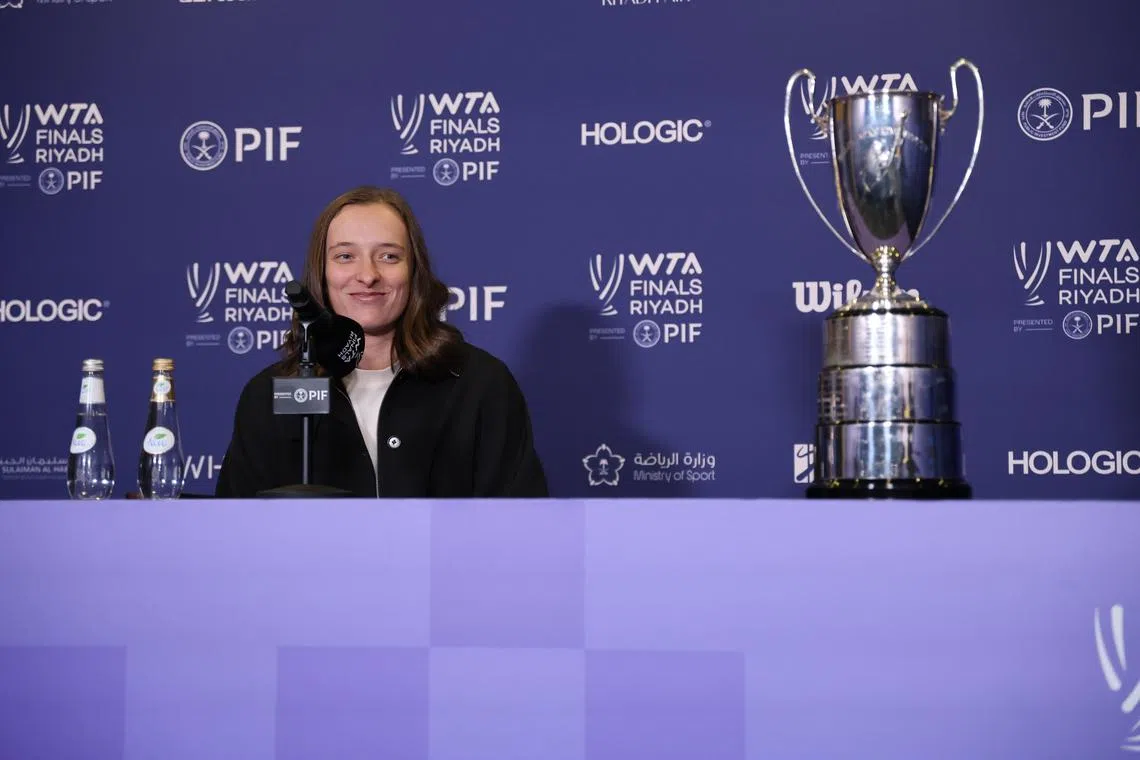The importance of those high-pressure tiebreaks in tennis
Sign up now: Get ST's newsletters delivered to your inbox

Iga Swiatek during a press conference ahead of the WTA Finals. The Pole is 6-2 in tiebreakers against top-10 players, which may give her an edge when required.
PHOTO: EPA-EFE
Follow topic:
NEW YORK – The WTA Finals in Riyadh brings together 2024’s top players for one final showdown.
But just because the tournament features only the game’s best does not guarantee close sets. In the past two years, about as many sets have been decided 6-0 or 6-1 as they have 7-5 or 7-6.
But it is success or failure in those 7-6 sets, decided by a seven-point tiebreak, that can make or break a player’s season and season finale.
“The mindset is the most important part of the tiebreak,” said Pam Shriver, a Hall of Famer, ESPN analyst and coach for 19th-ranked Donna Vekic.
Shriver, who won 21 Grand Slams in doubles, said having someone by her side helped her remain calm during tiebreaks. She added: “When you take your time, things fall into place. The athlete who rushes gets into trouble.”
Iga Swiatek dominated Jessica Pegula 6-1, 6-0 in the 2023 tournament’s final, and she is also the best in tiebreaks among the elite eight. In the past two years, she is 6-2 in tiebreaks against top-10 players.
“You need to be extra focused in tiebreaks, especially on the first point, because you want to start well,” world No. 4 Jasmine Paolini said.
Shriver also said that most players include tiebreaks at the end of practice, but many do not emphasise how to cope in those situations.
Sixth-ranked Pegula, for one, said that “you just have to get used to playing them and managing the scoreline through experience in matches”.
She noted that while the men’s ATP Tour is filled with big servers who can seize control of the race to seven points with one mini-break, there are more shifts in momentum for the women. In a way, it is harder to train for it.
But Shriver, who said she thinks that even off-court visualisation exercises can help prepare for tiebreaks, believes that they are worth practising for more than just playing points.
“You can’t duplicate the crazy emotions of a tiebreak, but I do believe rehearsing it can get the adrenaline going and help with the real ones,” she said. “These are things you can get better at.”
Top-ranked Aryna Sabalenka, the 2024 Australian and US Opens champion, agreed that players can prepare for it.
“I play a lot of tiebreaks with my hitting partner, who puts me under pressure so I can work on getting through the difficult points.
“The mental challenge on the tiebreak is to keep playing aggressively, to keep going for your shots, to put the pressure on your opponent,” said the Belarusian, who is known for her aggressive style of play.
“You have to trust your game and just go for it. You don’t want to be overprotective.”
By contrast, Pegula said she plays “a little safer” in tiebreaks. In a full game, she said, players have more room for error if they blast and miss a first serve.
“In a tiebreak, I go for a higher percentage on my first serve so there’s not as much pressure on my second serve, and I hit with more margin during rallies,” she said.
“If you’re feeling pressure, then your opponent is too, so putting the pressure on them to make shots is a good idea.”
Ultimately, it may not always make sense to have one specific approach to tiebreaks, said Pere Riba, the coach for seventh-ranked Zheng Qinwen.
“Every situation is different, so you have to read the situation,” he said. “How the player is feeling in the moment is the most important thing.” NYTIMES

